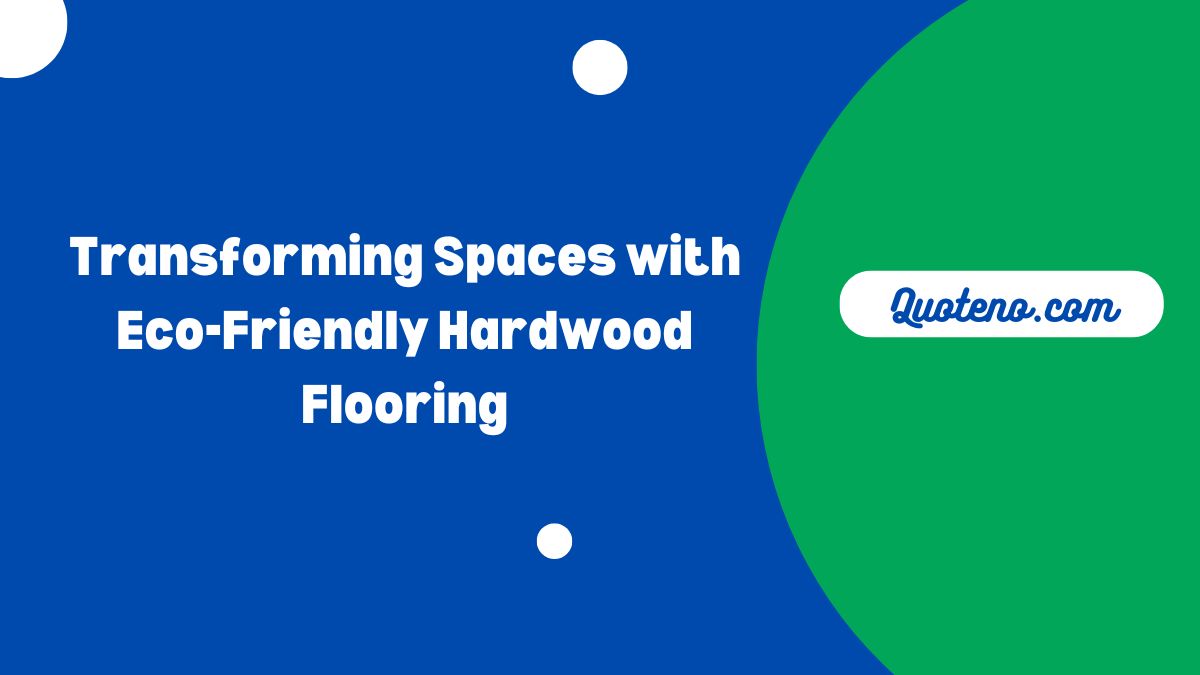Creating a beautiful and sustainable living environment starts from the ground up. Eco-friendly hardwood flooring offers an exceptional option for modern home interiors, combining unparalleled aesthetic appeal with environmental responsibility. As homeowners and builders increasingly embrace eco-friendly solutions amid rising environmental concerns, the demand for sustainably sourced hardwood has soared, merging style with a commitment to the planet.
Investing in hardwood flooring made from responsibly sourced materials doesn’t just enhance the visual appeal of a home; it also plays a critical role in reducing ecological footprints. These choices resonate well with individuals keen on preserving the environment while enjoying the timeless elegance and versatility that hardwood flooring brings to both traditional and contemporary home designs. This guide will help you select the correct type of hardwood, understand industry innovations, and effectively maintain your floors’ timeless beauty.
Table of Contents
Key Takeaways
- Eco-friendly hardwood flooring is a sustainable option for modern interiors.
- Advances in wood technology enhance durability and style.
- Practical tips for choosing and maintaining hardwood floors.
Introduction to Eco-Friendly Hardwood Flooring
Hardwood flooring has long been cherished for its warmth, beauty, and durability. Eco-friendly hardwood aligns these traditional benefits with modern-day environmental consciousness, made possible by sustainable harvesting and production processes. These methods ensure minimal environmental impact and allow homeowners to opt for renewable and responsibly managed resources. Furthermore, eco-friendly hardwood tends to be low-VOC, emitting fewer volatile organic compounds, contributing to healthier indoor air quality. This article explores how wide plank wood flooring elevates a space’s look and feel and aligns with growing sustainability trends.
Choosing the Right Hardwood for Your Space
Choosing the perfect hardwood for your space involves carefully considering various factors. Aesthetic appeal is essential, but functionality should not be overlooked, especially in areas with high foot traffic. Consider the sustainability of the wood itself to ensure an environmentally friendly choice. With options ranging from oak to maple and even bamboo, there’s a type to suit every taste and requirement, each with its qualities and ecological benefits.
Types of Eco-Friendly Hardwood
- Oak: Renowned for its robustness and distinctive grain pattern, oak is ideal for areas that endure high traffic. It combines strength with timeless beauty.
- Maple: With a lighter finish, maple is a superb choice for those leaning toward minimalist or contemporary design aesthetics. It provides a bright and airy feel.
- Bamboo: Although technically a grass, bamboo’s rapid growth makes it a remarkable renewable option, praised for its sustainability and exotic allure.
The Environmental Impact of Conventional Flooring
Traditional flooring options like vinyl or carpet are often associated with significant carbon footprints due to the energy and materials required in their production. These processes can lead to substantial environmental degradation and pollution. In contrast, sustainable flooring reduces the environmental impact by utilizing less energy and emitting fewer pollutants throughout its lifecycle.
Innovations in Hardwood Flooring
The industry has witnessed significant innovations aimed at enhancing the durability and aesthetic appeal of hardwood flooring. Engineered hardwood is one of the leading advancements, featuring a cross-layered construction that augments its structural integrity and reduces susceptibility to moisture. This makes it an excellent choice for environments where traditional hardwood might not be suitable. Additionally, reclaimed wood has emerged as a popular option, offering a blend of rustic charm and eco-friendliness by repurposing existing timber.
Maintaining Hardwood Flooring
Proper maintenance is crucial for preserving the longevity and luster of your hardwood flooring. Regular cleaning to remove dirt and debris is fundamental to prevent scratches. Vacuuming or sweeping frequently is recommended, alongside a damp mop, for a deeper clean. However, it’s crucial to avoid using excessive water, which can damage the wood. Applying a suitable finish or sealer adds an extra layer of protection against wear and stains, maintaining the wood’s natural beauty over time. Avoid common pitfalls such as harsh chemical cleaners or allowing liquid spills to sit, which can lead to discoloration and damage.
Popular Trends in Eco-Friendly Hardwood Flooring
The design world continues to embrace wider planks and finishes that accentuate wood’s innate beauty. Eco-conscious homeowners increasingly opt for natural finishes that showcase the wood’s organic patterns, including knots and grains, to create a unique and personalized aesthetic. Case studies illustrate how eco-friendly flooring solutions can seamlessly integrate into modern homes, from urban apartments to rustic retreats, each adding significant value and character.
Health and Wellness Benefits
Beyond their aesthetic and environmental advantages, hardwood floors contribute positively to indoor health quality. Unlike carpets, they do not harbor dust, allergens, or pet dander, making them an ideal flooring choice for individuals with allergies or respiratory concerns. Research suggests that hardwood flooring can enhance a home’s hygiene, improving overall air quality and the wellness of those residing within. For more information on how hardwood can benefit health, explore the health benefits of hardwood flooring.
Conclusion: Creating a Sustainable Space
The decisions made when selecting flooring go beyond mere style; they impact the environment, health, and home quality. By opting for eco-friendly hardwood, you embark on a journey that promotes sustainability and environmental stewardship. Whether renovating an entire house or updating a single room, consider the broader implications of your design choices. Embrace flooring that respects and nurtures our planet, ensuring your living spaces reflect personal style and a commitment to a sustainable future.
- Creative Ways to Make Camping Trips Fun for Everyone - November 7, 2025
- Benefits of Designing Energy-Efficient Homes - October 30, 2025
- Assessing the Reliability of Modern Library Resources for Engineers - October 28, 2025

